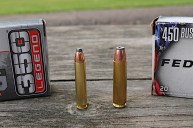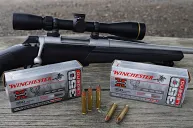Many hunters love raw power in their firearms and there's no question the iconic .45-70 Government and the slightly newer 450 Bushmaster deliver that in spades. Both straight-walled cartridges have been around for a while. In the case of .45-70, it's been around since 1873, when it was first used by the U.S. Army. The concept for the 450 Bushmaster was technically around for decades, originally conceptualized by legendary outdoor writer Jeff Cooper as .45 Professional. The idea was later adopted by Hornady and rose in popularity after many Midwestern states like Michigan and Ohio loosened regulations to allow straight wall rifle cartridges. Many of these states had previously restricted whitetail deer hunters to shotguns or muzzleloaders only.
Both the .45-70 Gov and 450 Bushmaster offer excellent muzzle velocity and tons of stopping power for a bevy of big game animals. Both "big bores" will easily handle bears, and even elk easily. For deer, hogs, and other mid-sized game, these rifle cartridges offer true knockdown power that will usually drop the animals where they stand. No tracking job required. The only hard part is deciding which one is best for your hunting style. Today we'll look specifically at how these two calibers stack up against one another to help you make a more informed decision on how to spend your hard-earned money.
What's the Difference Between .45-70 and 450 Bushmaster?

YouTube Screenshot: WHO_TEE_WHO
At first glance, it seems like these two rounds are very similar. After all, both use a .45 caliber bullet. The .45-70 has a diameter of approximately .458 inches while the 450 Bushmaster's diameter is .452 inches. However, there are many subtle differences between these two rounds. The first we should mention is the case length. The 450 comes in at 1.70 inches while the .45-70 sits at 2.1 inches.
The reason we mention this is because many Midwestern states base their legal rifle calibers around case length. For example, in Michigan's Zone 3, hunters are limited to a maximum case length of 1.80 inches. That clearly leaves the .45-70 out of the equation. This isn't a hard rule for every state, but it's worthy of consideration for any hunter looking at these two rounds.
The other main difference is the types of hunting rifles available. The .45-70 is mostly available for lever action platforms like the Marlin 1895 or the Winchester Model 1886. There are some single-shot options like the Ruger No. 1 or CVA Scout 2, but most shooters will agree it is in lever guns that the .45-70 really shines. It has been the brush gun of choice for many backcountry hunters and Alaskan guides for that reason.
In contrast, the 450 Bushmaster has found its niche in semi-auto sporting and affordable bolt-action rifles. Guns like the Ruger American Rifle, and Savage Axis flew off store shelves in many Midwestern states after wildlife agencies started allowing these rifles. Those in western states may find it odd, but understand that hunters in places like Iowa, Michigan, Ohio, and Indiana had few long range options out to 200 yards before the 450 was legalized.
.45-70 vs 450 Bushmaster Ballistics

Travis Smola
Some of the bigger differences start when you start comparing ballistics. The .45-70 is a very old round, but the old black powder design has come a long way since it was originally introduced. However, it is usually much slower than the 450. The old school lead rounds are usually traveling with a muzzle velocity between 1,300 and 1,500-fps. These rounds deliver a muzzle energy between 1,600 and 1,700-foot pounds. Modern factory loads have improved the speed and energy of the round significantly.
For instance, Hornady's 325-grain FTX LEVERevolution cartridges can do 2,000-fps speeds and deliver up to 3,000-foot pounds of muzzle energy. Federal Premium 300-grain Power-Shoks are capable of about 1,850-fps and 2,280-foot pounds of muzzle energy.
The nice thing about .45-70 is the bevy of bullet weights available. A 300-grain bullet is almost standard for the Gov, but they can run as high as 500 grains if you're looking for serious stopping power.
The 450 Bushmaster by contrast tops out at about 300 grains. The most common factory loads you'll find on the shelves are around 250 grains, which is perfect for most deer hunting scenarios. The 450 has a clear edge over the .45-70 in terms of speed. A Hornady Black 250-grain FTX or FTX Custom is doing about 2,200-fps with 2,686 pounds of muzzle energy.
Federal Premium also makes a 300-grain Power-Shok for the 450 and these cartridges have a slight edge over the .45-70 with a 1,900-fps muzzle velocity and 2,400-foot pounds of muzzle energy.
If you start comparing trajectories of the .45-70 and 450 Bushmaster, you'll find many manufacturers put the drop at zero for 100 to 200 yards depending on the type of bullet for both calibers. Again, modern advancements have helped the .45-70 make up a lot of ground. However, on the range, most shooters will agree the 450 Bushmaster shoots flatter than the .45-70, which drops off much more quickly after 200 yards. That's about the furthest most people are going to want to shoot either of these rounds anyway. Neither is really designed built for extreme precision shooting to distances beyond that. They are both much more comfortable in that 100 to 150-yard window. Which is just fine, because in most scenarios, especially here in the Midwest where the 450 is popular, you don't get a lot of shots that long at deer or other game anyways.
How To Choose Between These Two Rounds

johnaudrey via Getty Images
Both these cartridges are very capable and for hunters on the fence, we think it makes more sense to look at this debate in terms of practicality and legality than the opinion of one being better than the other. It doesn't make a lot of sense to buy a .45-70 if it's not legal in your area. (Many Michigan hunters were quite peeved when .45-70 was not on the list of legal cartridges for the southern half of the state.
For larger animals, I'd probably want the proven stopping power of the .45-70 if I was looking for an Alaskan brush gun or something for elk or moose. It has a proven track record with all these animals. On the other hand, we like the 450 for deer for the better accuracy. You'll also probably waste slightly less meat due to the smaller bullet weights. I'd also pick the 450 for feral hogs simply because of the round's compatibility with semi-autos.
In terms of rifle costs, the 450 usually wins that one. Most .45-70 rifle offerings are on the higher end, especially the classic lever guns. It's not unusual for a .45-70 to cost $1,000 to $2,000 new. They are also usually more limited in design. What you see is what you get. Meanwhile, the 450 Bushmaster has many fantastic budget rifle options in the $400 to $600 range available with a variety of finishes, stock offerings, and barrel lengths. If you look to buy used, it can be even cheaper than that. Mostly because many Midwestern gun shops are loaded with 450s since the introduction of the 350 Legend to those states.
In terms of ammo costs, it's almost a wash between these two. Factory ammo tends to run $50 to $60 for a box of 20. It gets more expensive if you start buying a premium brand like Buffalo Bore, which can go for $70 to $90 a box. So, these are not cheap to shoot by any means. It's little wonder most shooters of either cartridge get into reloading. The .45-70 does have the edge in terms of availability and ammo types available. This cartridge has been around forever, and you'll be hard pressed to not find at least one box of these rounds available at most sporting goods retailer regardless of location. It's not that the 450 has proven to not be readily available in most areas, because it has. However, there are often fewer options than you'll find with .45-70.
We highly recommend taking the time to seriously think about what type of hunting you're planning to do with this rifle and then checking out things like ammo availability in your area before coming to a final decision. A little homework now helps to ensure you get the rifle you want and need and avoids any unwanted headaches later. It's a tough decision, but most hunters should be able to find the practicality they need in one of these two calibers.
For more outdoor content from Travis Smola, be sure to follow him on Twitter and Instagram For original videos, check out his Geocaching and Outdoors with Travis YouTube channels.




